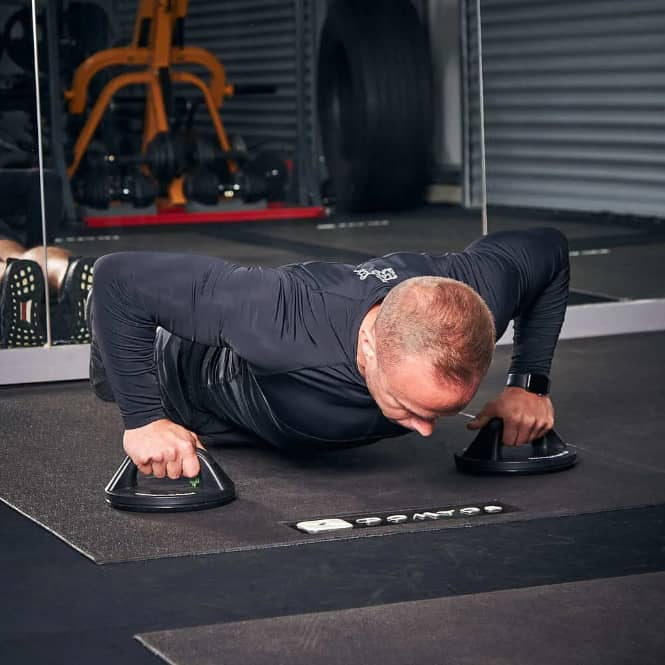Push up bars are a versatile fitness tool that elevates your workout routine. They might look simple, but they bring benefits beyond the standard push-up. Using one can revolutionise the way you approach this classic exercise.
In this guide, we’ll dive into this dynamic gym apparatus. Read on to explore their advantages, the techniques, and how to blend them into your regimen.
Ready to make the most out of your push-up bar experience?
Understanding Push-Up Bars

Push-up bars are fitness accessories designed to enhance the classic push-up exercise. They elevate your hands, allowing for a deeper range of motion and reduced strain on your wrists. Think of them as an upgrade to traditional push-ups performed directly on the floor.
There are two main types of push-up bars: rotating and non-rotating. Rotating bars are often equipped with a swivel mechanism. They engage more muscles by allowing your wrists to rotate as you move. A great example is the Physioroom Rotating Push Up Handles. The ergonomically designed handle is comfortable to use. It allows you to rotate the plate to suit your push-up style.
In contrast, non-rotating bars offer stability for precise form. Choosing the right type depends on your fitness level and comfort.
Setting Up Your Push Up Bars
Before diving into your push-up routine, it’s crucial to create an optimal setup. Begin by selecting a workout surface that is even and non-slippery. Alternatively, you may invest in a non slip yoga mat.
Once your surface is ready, position the push-up bars shoulder-width apart or a bit wider. This placement encourages a natural hand position. Moreover, it engages the chest, shoulders, and triceps effectively.
Maintain proper alignment by setting the bars at a distance. Ensure it allows your body to maintain a straight line from head to heels during the push-up motion.
Proper Push-Up Technique

Achieving the right body alignment is key to maximising the benefits of push-up bars. Place your hands firmly on the bars, ensuring they’re directly under your shoulders. This alignment prevents unnecessary stress on your wrists and promotes proper muscle engagement. Keep your shoulders positioned directly above your wrists to maintain stability.
As you perform the push-up, focus on maintaining a straight line from your head to your heels. Avoid any sagging or arching. Engage your core muscles throughout the movement to enhance your stability. In fact, doing so will also protect your lower back.
Additionally, remember to keep a neutral spine. Maintain a straight posture that optimises muscle activation and minimises strain.
Steps to Perform Push-Ups with Push Up Bars UK
-

PhysioRoom Rotating Push Up Handles Initial position: Place your hands on the push-up bars. make sure they align with your shoulders. Your body should form a straight line from head to heels, engaging your core for stability.
- Downward movement: Bend your elbows to lower your body, maintaining a straight alignment. Keep your elbows close to your sides as you descend, allowing your chest to approach the bars.
- Push back up: Push through your palms to extend your elbows, returning to the initial position. Maintain a straight line from head to heels throughout the motion.
Tips for beginners
Begin with a manageable number of repetitions, such as 5-10, to avoid overexertion. Focus on maintaining proper form. Then, gradually increase the reps as you build strength. Listen to your body and take breaks as needed. Over time, you’ll notice improved strength and endurance. This will allow you to advance your push-up routine confidently.
Common Mistakes to Avoid
Looking for ways how to use push up bars the right way? While using one, watch out for common errors that can hinder your progress:
- Flaring elbows: Allowing your elbows to point outward instead of staying close to your body is a no-no. Otherwise, this positioning can strain your shoulders and wrists, leading to discomfort.
- Sagging hips: Allowing your hips to drop during the movement disrupts proper alignment. It reduces the effectiveness of the exercise and potentially straining your lower back.
- Improper hand placement: Placing your hands too far forward or backward on the bars is also not ideal. It can affect your stability and form, impacting the targeted muscle engagement.
By focusing on correct alignment, you’ll ensure an effective and safe push-up routine.
Mastering the use of push-up bars is now within your grasp! Seeking professional gym equipment to amplify your push-up game? Consider the ab bench workout. Explore the offerings at Physioroom for a comprehensive range of fitness gear!
For your next read, delve into: What Is a Suspension Trainer?


